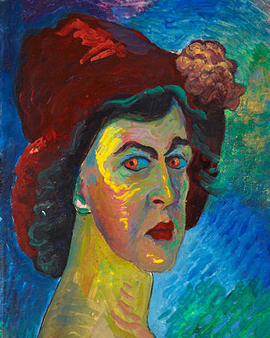


The Russian painter Marianne von Werefkin was an outstanding figure of German Expressionism. She came from a Russian noble family and was born on 29 August 1860 as Marianna Vladimirovna Werefkina in Tula. Her artistic talent was encouraged at an early age and she received academic drawing lessons at the age of fourteen. In St. Petersburg she took private lessons with Repin. While hunting she accidentally shoots through her right hand. Through persistent practice she succeeds in painting with her right hand again. She masters realistic painting so perfectly that she is called "Russian Rembrandt". In 1891 she met the painter Alexej von Jawlensky. Five years later she moved with him to Munich.
In the Bavarian capital, she initiates a salon where the bohemian scene of Munich meets. She also founds the Lukasbruderschaft, the nucleus of the "Neue Künstlervereinigung München" and the "Blauer Reiter". After the birth of her son, the crisis between Jawlensky and Marianne von Werefkin intensifies. She travels to France several times with her son. After she has started to paint again, she often works in Murnau with Jawlensky, Kandinsky and Gabriele Münter. Together with Jawlensky, Oscar Wittenstein and Adolf Erbslöh she founded the "Neue Künstlervereinigung München" (New Artists' Association Munich), of which Kandinsky will soon become chairman.
In 1907 Werefkin created his first expressionist paintings, inspired by Vincent van Gogh, Paul Gauguin and Henri de Toulouse Lautrec. This earned her the nickname "The Frenchwoman". In terms of motifs and iconology, she often borrows from the works of Edvard Munch. Werefkin and Jawlensky participated with the group "Der Blaue Reiter" in an exhibition at the gallery "Der Sturm" in Berlin in 1913. Together with Jawlensky Werefkin moved to Switzerland in 1914, where they ended up in Ascona after several moves. Jawlensky separates from Werefkin in 1921. She earned her living by painting postcards and posters and writing articles, among others for the Neue Zürcher Zeitung.
The paintings of her late work no longer seem so shocking. They become more enigmatic and narrative. Typical Russian features in the colouring now become very clear. In February 1938 Werefkin died in Ascona, where she was buried according to Russian Orthodox rites. Most of her estate is in the Fondazione Marianne Werefkin in Ascona.

The Russian painter Marianne von Werefkin was an outstanding figure of German Expressionism. She came from a Russian noble family and was born on 29 August 1860 as Marianna Vladimirovna Werefkina in Tula. Her artistic talent was encouraged at an early age and she received academic drawing lessons at the age of fourteen. In St. Petersburg she took private lessons with Repin. While hunting she accidentally shoots through her right hand. Through persistent practice she succeeds in painting with her right hand again. She masters realistic painting so perfectly that she is called "Russian Rembrandt". In 1891 she met the painter Alexej von Jawlensky. Five years later she moved with him to Munich.
In the Bavarian capital, she initiates a salon where the bohemian scene of Munich meets. She also founds the Lukasbruderschaft, the nucleus of the "Neue Künstlervereinigung München" and the "Blauer Reiter". After the birth of her son, the crisis between Jawlensky and Marianne von Werefkin intensifies. She travels to France several times with her son. After she has started to paint again, she often works in Murnau with Jawlensky, Kandinsky and Gabriele Münter. Together with Jawlensky, Oscar Wittenstein and Adolf Erbslöh she founded the "Neue Künstlervereinigung München" (New Artists' Association Munich), of which Kandinsky will soon become chairman.
In 1907 Werefkin created his first expressionist paintings, inspired by Vincent van Gogh, Paul Gauguin and Henri de Toulouse Lautrec. This earned her the nickname "The Frenchwoman". In terms of motifs and iconology, she often borrows from the works of Edvard Munch. Werefkin and Jawlensky participated with the group "Der Blaue Reiter" in an exhibition at the gallery "Der Sturm" in Berlin in 1913. Together with Jawlensky Werefkin moved to Switzerland in 1914, where they ended up in Ascona after several moves. Jawlensky separates from Werefkin in 1921. She earned her living by painting postcards and posters and writing articles, among others for the Neue Zürcher Zeitung.
The paintings of her late work no longer seem so shocking. They become more enigmatic and narrative. Typical Russian features in the colouring now become very clear. In February 1938 Werefkin died in Ascona, where she was buried according to Russian Orthodox rites. Most of her estate is in the Fondazione Marianne Werefkin in Ascona.
Page 1 / 2






